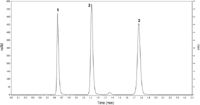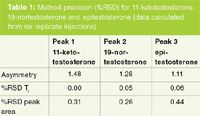Analysis of Testosterones Using a Core Enhanced Technology Accucore HPLC Column
Thermo Fisher Scientific Application Note
This application note demonstrates the use of the Thermo Scientific Accucore RP-MS HPLC column for the fast analysis of three testosterones.
Introduction
Accucore HPLC columns use Core Enhanced Technology to facilitate fast and high efficiency separations. The 2.6 µm diameter particles are not totally porous, but rather have a solid core and a porous outer layer. The optimized phase bonding creates a series of high coverage, robust phases. Accucore RP-MS uses an optimized alkyl chain length for more effective coverage of the silica surface. This coverage results in a significant reduction in secondary interactions and thus highly efficient peaks with very low tailing. The tightly controlled 2.6 µm diameter of Accucore particles provides much lower backpressures than typically seen with sub-2 µm materials.
11-ketotestosterone, 19-nortestosterone and epitestosterone are all related to testosterone. 11-ketotestosterone is an oxidized form of testosterone. 19-nortestosterone contains an additional methyl group in comparison to testosterone and epitestosterone and is an inactive epimer of testosterone. All three compounds are anabolic steroids, which promote protein synthesis within cells, particularly in muscles. 19-nortestosterone occurs naturally at low levels (0.4 ng/mL) in the body and is routinely tested for in athletes.
The separation of these three compounds and more significantly the speed of analysis are demonstrated in this application.
Experimental Conditions
Sample Preparation
Working standard contained 50 µg/mL of each testosterone in mobile phase
Thermo Scientific Column
Accucore RP-MS 2.6 µm, 100 × 2.1 mm (P/N 17626-102130) Measured pressure: 300 bar
Thermo Scientific Accela HPLC system
Column temp: 40 °C
Injection volume: 1 µL
Flow-rate: 0.6 mL/min
UV detection: 54 nm
Mobile Phase
60:40 (v/v) water/acetonitrile
Consumables
Fisher Scientific HPLC grade water (P/N W/0106/17)
Fisher Scientific HPLC grade acetonitrile (P/N A/0626/17)
NSC Mass Spec Certified 2 mL clear vial with blue bonded PTFE silicone cap (P/N MSCERT4000-34W)
Results

Figure 1: Chromatogram for 11-ketotestosterone (1), 19-nortestosterone (2) and epitestosterone (3) separated on an Accucore RP-MS 2.6 µm 100 à 2.1 mm column.
The analysis was carried out on an Accucore RP-MS 2.6 µm, 100 × 2.1 mm column. 11-ketotestosterone, 19-nortestosterone and epitestosterone eluted in under 2 minutes (Figure 1).
Replicate injections of the testosterone mix showed that Accucore RP-MS produced stable and reproducible results (Table 1).
Conclusions
Accucore RP-MS columns successfully separated 11-ketotestosterone, 19-nortestosterone and epitestosterone in less than 2 minutes, providing an excellent choice for the fast analysis of testosterones, allowing high sample throughput.

Table 1: Method precision (%RSD) for 11-ketotestosterone, 19-nortestosterone and epitestosterone (data calculated from six replicate injections).
Thermo Fisher Scientific
Tudor Road, Manor Park, Runcorn, Cheshire WA7 1TA, UK
tel: +44 (0) 1928 534110

Silvia Radenkovic on Building Connections in the Scientific Community
April 11th 2025In the second part of our conversation with Silvia Radenkovic, she shares insights into her involvement in scientific organizations and offers advice for young scientists looking to engage more in scientific organizations.
Regulatory Deadlines and Supply Chain Challenges Take Center Stage in Nitrosamine Discussion
April 10th 2025During an LCGC International peer exchange, Aloka Srinivasan, Mayank Bhanti, and Amber Burch discussed the regulatory deadlines and supply chain challenges that come with nitrosamine analysis.
Removing Double-Stranded RNA Impurities Using Chromatography
April 8th 2025Researchers from Agency for Science, Technology and Research in Singapore recently published a review article exploring how chromatography can be used to remove double-stranded RNA impurities during mRNA therapeutics production.



















